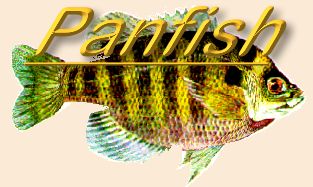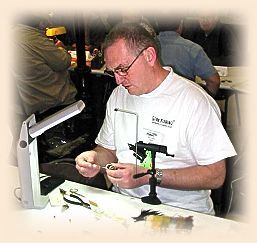Publisher's Note:
Rick's fishing season is over until the ice melts,
but we have a nice stash of articles he has written
in the past as ideas or events occured to him. We hope
this will explain apparent 'out of season' articles.
I headed out on Saturday morning for my normal
fishing excursion. On Tuesday night and early
Wednesday morning we had from 3.5 to 4 inches
of rain fall. I knew one of the ponds I fished
and had a lot of weed growth on the surface and
I thought this rain might have washed those weeds
off the surface and down the drain pipe.
When I got to the pond, I found two things that
could be a problem. First I had forgotten to put
my life jacket and canoe paddle in the truck. I
swim like a rock so I don't go out in the canoe
without the life jacket. I drove back home and
picked those up and returned to the pond.
At this pond I park in the overflow spillway at
the end of the dam. The second problem was that
water was very near to coming over this spillway.
I unloaded the canoe but did not put my rods in
yet. I paddled down to the drain pipe to see what
might be going on.
There is a grating around the drain pipe to keep
debris out of the pipe. The rain had washed a lot
of small sticks and a few limbs into the pond and
they were smashed against the grating. The pond
weeds had come down to the grating and were trapped
in the sticks and such. This made a very effective
dam. Very little water was going down the pipe.
I decided to clean a bunch of this stuff away from
the grating. The first few sticks came off pretty
easily, but then things got harder. I was able to
toss the sticks up onto the dam so they would be
out of the way. With the sticks out of the way the
water started to flow. Now I had to fight the water
flow as I tried to get the rest of the junk away from
the grating. It continues to amaze me the power that
water has while it is moving.
I finally realized that I had a good sized limb
that was around the grating. I tied onto the limb
with my anchor rope and then moved the canoe back
about twenty feet. I dropped the anchor and tied
it off so the canoe would not move. I then grabbed
the rope to the limb and started pulling. I could
tell that I was gaining a little bit of ground as
I pulled on the limb but it was not very fast. I
decided to move the canoe about 15 feet to the side
and then pull again. At this point I got the limb
to move a little better. I finally got it away from
the drain and could take it to shore.
This really let the water start to flow. I went
back to the drain and took some more of the smaller
limbs away from the grating. This allowed the surface
weeds to go down the drain pipe.
With the drain clear I went back to get my rods
and headed for the other end of the pond. I did
not want to fight the current as the water drained
out.
All the water that had washed into the pond carried
a lot of sediment with it. With the drain plugged
the water had not been able to run out so all the
sediment was suspending in the water column. I
decided to go with flies that had some flash in
them.
I had several hits on the flies but I was not
able to hook any fish. I would feel weight on
the line and then there would be nothing. I
changed to other flies and sizes but that did
not help the process. I was wondering if the
fish were short striking me, but smaller flies
and even a few with a tandem hook in the tail
material did not result in hook ups.
Time to try one of my experiments. I have tied
a few flies with bead chain eyes and a strip of
closed cell foam on the hook shank. I put the
hook in the vice and then turn it 90 degrees. I
want the hook horizontal and not vertical. I then
tie in the bead chain eyes on the bottom of the
hook and wrap the foam on the top of the shank
with thread. This is a very thin (1/16") strip
of foam.
I have a few Streamer nymphs and a few Marabou
Misses (See Ricks Favorite Crappie flies) tied
up this way.
I tied on a streamer nymph and cast it out. I had
not moved the fly far when the rod tip went down
and I had a fish on. This was a nice crappie, hooked
in the roof of the mouth. A few casts later I had
a fairly good bass take the fly, again hooked in
the roof of the mouth. In the next 30 minutes I
caught three more crappie and had several fish
get off after hitting the fly.
My trouble was that I had run out of time. Most
of it was my fault for having to go back home to
get the life jacket and paddle(a mistake I will
not repeat for a long time). Cleaning the grate
took time but needed to be done.
Every fish I caught was hooked in the top of the
mouth. My guess is that the fish were rolling on
the fly when they hit it. With flies tied normally
I was hooking the crappie in the thin membrane on
the side of their mouth and pulling the hook out.
By using the other flies I was able to hook the fish.
My wife razzed me as did several other folks that
I normally take fish to. They all said I must be
losing my touch. It is wonderful to get support.
I hope you can get out on the water. ~ Rick ziegeria@grm.net
|

